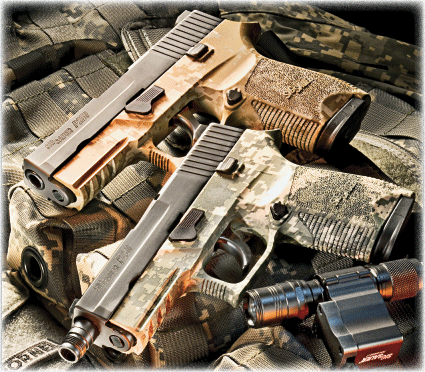Many firearm enthusiasts are already aware of the P250 concept. Take a universal chassis and serialize it. Then allow the operator to decide which grip frame best fits their hand, select a caliber that best serves all things considered and attach the slide. It is already recognized as one of the most revolutionary ideas conceived in this century. It’s ambidextrous. It’s straightforward. It’s that simple.
Since the Sig Sauer P250 9mm Duo unveiling, new details make the Sig Sauer P250 9mm Duo stand apart from the model introduced last year. The new Tactical All Terrain Digital pattern mirrors the design worn on the new US Army utilities while the desert Digital Camo pattern mimics the new camouflage uniform worn by US Marines when deployed to desert environments. These dipped coatings should certainly capture the attention of those in the armed forces.
If the digital camouflage doesn’t grab the attention of operators, a threaded barrel just might. Currently, the Digital Camo model features a shorter barrel than the All Terrain model, just like the standard P250. The barrel of the Tactical All Terrain model, however, is cut to a greater length and turned for threads to accept a suppressor. I immediately began thinking about the effect the length would have on this model’s accuracy potential.
Advertisement — Continue Reading Below
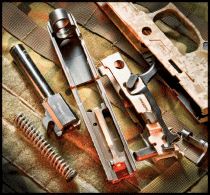 I removed the barrels from each and measured the length of the bore to the breach face with a dial caliper. The barrel on the Tactical All Terrain model measured 4.8 inches while the bore length on the standard barrel measured 3.8 inches.
I removed the barrels from each and measured the length of the bore to the breach face with a dial caliper. The barrel on the Tactical All Terrain model measured 4.8 inches while the bore length on the standard barrel measured 3.8 inches.
There are very few parts to the Sig Sauer P250 9mm Duo, easing maintenance and cleaning. Those who get the Sig Sauer P250 9mm Duo can decide for themselves, which grip best suits their hand while caliber upgrades can be easily obtained. A modular grip frame allows the shooter to custom fit the pistol and the lack of manual safety means that fundamental training could be accomplished more swiftly. And in the field, fewer controls could mean fewer things to fumble during a critical moment.
Advertisement — Continue Reading Below
The slide moves along steel rails and is coated a scratch-resistant Nitron formula. The slide lock lever appears on both side and the magazine release comes installed for right hands but can be switched for lefties. The slide can work with many combinations, so the P250 can be assembled for a variety of tasks.
Routine Maintenance
Most repair and maintenance issues of the P250 could be handled at a basic skill level. “We are having a hard time working up the armorer course for the P250,” says George Harris, director of training at the SIG SAUER Academy. “The actual armorer course would only take a few hours to teach. We would have to think of a few other things for students to do just to fill a day.”
M1911 and Beretta M9 shooters may require some time to warm up to the P250’s trigger. You can’t stage the trigger of the P250. If you try, more often than not you’ll throw the shot. “You’ve got to pull through the trigger,” says Rance Deware, senior instructor at the SIG SAUER Academy. This technique goes against my trained wisdom but my groups were unimpressive as I tried to anticipate the shot while gently drawing the trigger to the rear. “Just pull it,” he added. “You’ll shoot better, trust me.”
Advertisement — Continue Reading Below
Deware was right. During the accuracy test I tried each method (“staging” and “pulling”) with another experienced pistol shooter. The results were clearly definitive. At 7 yards, we shot five 5-shot groups and every single group shot by “pulling” through the trigger resulted in a group that was better than any group shot by “staging” the trigger. It baffles me, but it is true. Due to this revelation, the accuracy tests at 7, 10, 15 and 25 yards were done by the “pulling” method.
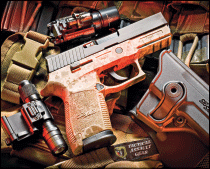 Shooting Impressions
Shooting Impressions
I had already witnessed a team of SIG SAUER employees perform continuous endurance testing at the SIG SAUER Academy. Numerous P250s were being shot with most exceeding 10,000 or 20,000 rounds. They weren’t just shooting ball ammo but my jaw dropped at the sight of Speer Gold Dot defensive loads being shot by the pallet. SIG SAUER had invested a considerable amount of money to make sure this product would run.
Shortly after I got home, I received a pair of P250s, one Tactical All Terrain model with the extended barrel and one Digital Camo with a standard barrel. I didn’t waste time before heading out to the range. I collected some military-issue 115-grain FMJ 9mm that I had been saving for a test like this. I wanted to see if these pistols were worthy for duty and if the threaded barrel benefited from any additional accuracy.
Advertisement — Continue Reading Below
These pistols’ 7.5-plus-pound long trigger pull meant that a test with a Ransom Rest was out of the question. The test group fired to the best of our ability while standing at 7, 10 and 15 yards. At 25 yards we fired from a supported bench rest position.
We chose to get familiar to the trigger and test the trigger theory at 7 yards before moving back. The best five-shot group obtained at 7 yards was 1.12 inches. This isn’t a result of match accuracy but it is better than the combat accuracy of other DAO pistols in this class. Staging did, in fact, prove worse for accuracy so the rest of this evaluation would be completed while pulling through the trigger.
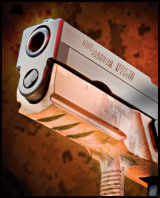 Moving 3 yards back to the 10-yard line, the 5-shot groups didn’t change much, staying well under 2 inches. However, at 15 yards, the groups started opening up by an extra inch. At the 25-yard bench, we shot five 5-shot groups each averaging just under 3 inches for the Tactical All Terrain model with the longer barrel and just over 3.5 inches for the standard-length Digital Camo model. When comparing group size to group size, it was obvious that the Tactical All Terrain pistol benefited from the longer barrel in all except from the 7-yard line.
Moving 3 yards back to the 10-yard line, the 5-shot groups didn’t change much, staying well under 2 inches. However, at 15 yards, the groups started opening up by an extra inch. At the 25-yard bench, we shot five 5-shot groups each averaging just under 3 inches for the Tactical All Terrain model with the longer barrel and just over 3.5 inches for the standard-length Digital Camo model. When comparing group size to group size, it was obvious that the Tactical All Terrain pistol benefited from the longer barrel in all except from the 7-yard line.
Advertisement — Continue Reading Below
SIG SAUER’s P250 builds on the proven recoil operated, locked breach design of the 20th century. Production is accomplished here in the United States and the Germans are taking notice. “With millions of dollars invested in state-of-the-art machinery, our facility in New Hampshire is taking the lead in production of SIG SAUERs,” says Ron Cohen, president of SIG SAUER.
This consistency in production is reflected in the commonality of parts. A shooter doesn’t have to worry about fit when swapping parts or headspace when switching barrels. Quality control is held to strict standards, which was verified in a recent factory tour. Modern manufacturing equipment and tolerance checks were performed with German-engineered computer-aided machines.
A finishing department disassembled each product and carefully conducted a multi-point inspection. “We have nothing to hide,” says Eric VonBosse, product manager. “The red tags you see on guns are rejects. If something is rejected we find out why and see if we need to change a process. We are always looking for ways to improve things around here.”
Advertisement — Continue Reading Below
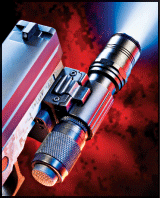 Final Notes
Final Notes
I don’t expect those faithful to the 1911 will like the trigger and polymer composite feel of this pistol. It is well balanced and certainly brings a new approach to the argument over the definition of a combat gun. It’s not going to win competitive shooting matches without some other options but it isn’t designed to. It’s designed to work reliably and intuitively for a broad spectrum of shooters. Perhaps this complicates matters. In the end, some might find that that SIG SAUER’s P250 solves them.
For more information, contact: SIG SAUER, 18 Industrial Dr, Dept. CH, Exeter, NH 03833; 603-772-2302; www.sigsauer.com.
